![]()
|
Stephen
Hughes &
Co |
Location and period of operation:
|
Stephen
Hughes |
Cobridge |
c.1835 |
1846 |
|
Stephen & Elijah
Hughes |
Cobridge |
1846
|
1853 |
|
Elijah
Hughes |
Cobridge |
1853 |
c.1868 |
|
John
V Hughes |
Cobridge |
1864 |
1864 |
NOTE: dates are approximate except those taken from announcements in the London
Gazette
Earthenware
manufacturers at the Bleak Hill Pottery, Cobridge,
Stoke-on-Trent, England
|
The London Gazette
18th May 1846
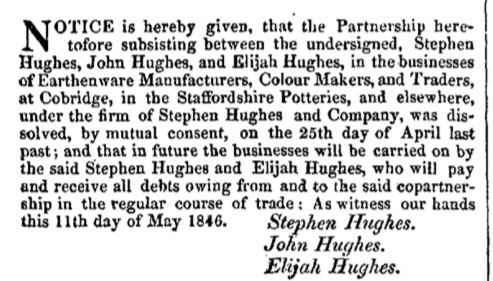
Notice that John Hughes
left the partnership
The London Gazette
7th January 1853
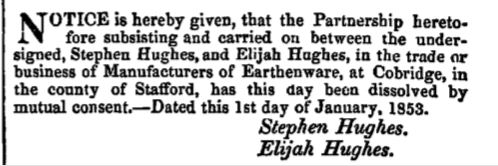
Notice of the dissolution
of the partnership between
Stephen and Elijah Hughes
The London Gazette
7th January 1853
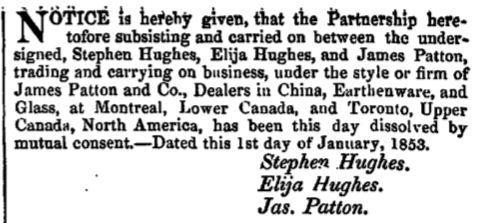
Notice of the dissolution
of the partnership between
Hughes and Patton as dealers in Canada
Hughes of Cobridge & Burslem This Hughes dynasty of potters does not appear to have had any close connection with the Hughes of Lane End/Delph, Longton.
At first sight it can appear from sources that Hughes of Cobridge and Burslem are two separate families or branches, with one in Cobridge and the other in Burslem. However, the potteries they worked and their homes were on the border between the two places and their addresses swap from the one place to the other apparently randomly. It appears that geographically they were in Cobridge.
Business Names
The sequence of partnerships was
Cowap, Hughes & Co 1820 to 1827
Hughes & Taylor 1827 to 1829
Thomas Hughes 1830 to 1834
Stephen Hughes & Co 1835 to 1846
Stephen & Elijah Hughes 1846 to 1852Stephen and Elijah then parted company and the two separate sequence of partnerships thereafter were
Stephen Hughes & Son January 1853 to 1855
Thomas Hughes etc 1855 etc etcA design was registered 17 April 1855 in the name of Stephen Hughes & Son, which is the only recorded instance of that style. Stephen was already dead and his son Thomas soon adopted his sole name as his trading style.
and
Elijah Hughes January 1853 to 1867
John V Hughes 1864 ?People
Thomas Hughes was born about 1785 at Hanley and as there are no parish registers for Hanley prior to 1797, his origins may never be found. He married Elizabeth Rowley in 1805 and they had at least 3 children, all of whom were christened at Hanley: Stephen born 1806, John born 1808 and Elijah born 1812 and Emma in 1820. Wife Elizabeth seems to have died and in 1829 Thomas remarried to Mary Fox and she in turn seems to have died, because it appears he married Ann Howell in 1834 and in 1851 he was living with wife Ann and daughter Emma at Beazley House, Chatterley, Staffs. He died 28 November 1851. It looks as if he retired from potting in 1834 and worked a small farm at Beazley House.
Stephen Hughes & Co was formed by the three sons; Stephen, John & Elijah. John left the partnership in 1846 and went on to make bricks instead. Stephen and Elijah continued until 1851 or 2 and then went their separate ways. Stephen died January 1855. His son Thomas continued the business, which grew into a major manufacturer, continuing until 1957.
Location
Thomas senior is said to have started the Waterloo Road Works, Cobridge/Burslem in 1820, although in Directories he is placed at Villa Pottery, Cobridge in 1830 & 1834. Stephen Hughes & Co and thereafter continued at Waterloo Road Works. When Elijah went on his own he took the Bleak Hill Works at Cobridge. Waterloo Road Works and Bleak Hill Pottery were very close to each other and the brothers both lived nearby on Waterloo Road/Bleak Hill.
The Wares
Earthenware and ironstone were produced, although few details can be found. The April 1855 design registration was for ironstone or granite-type tableware forms.
Three invoices survive from S Hughes, Cobridge to S & J Tams of Philadelphia. They are dated 3 August 1835, 20 April 1836 and 12 May 1836 and each is for a larger value and quantity than before, which suggests that Hughes had a growing business with Tams. The invoices are in the Warshaw Collection at The Museum of American History, Washington.
Jewitt comments
"Waterloo Road Works, established in 1820 (on the site of a very old pottery "on Bournes Bank", afterwards worked by William Harrison) by Mr Thomas Hughes (grandfather of the present owner), and carried on by him and his successors, Stephen Hughes & Co., till about 1856, since which time they have been continued solely by the present Mr Thomas Hughes, by whom the whole place has been enlarged, improved and modernised. The manufactory is now considered to be one of the best arranged in the town. The goods produced are all the usual articles in the hard durable "granite" or so called "ironstone china" for the American markets; they are of good quality and are produced both light and heavy to meet various requirements. Goods are also, to some extent, produced for the home trade. The mark stamped on the ware is THOMAS HUGHES, IRONSTONE CHINA."
Backstamps
Early wares do not appear to have been marked. Later, initial marks were used: S H & Co, S & E H and also S Hughes and probably S H?
S H & Co may have continued after the Stephen Hughes & Co partnership ended, where it was already in use and had been engraved as part of a pattern name backstamp.
S. Hughes & Son appears on some ironstone and dates from around 1853-5. The partners were Stephen Hughes & his son Thomas.
Elijah Hughes is believed to have used E H.
Source: The bulk of this information is from a post by Andrew J Pye on the Transferware Collectors Club message board.
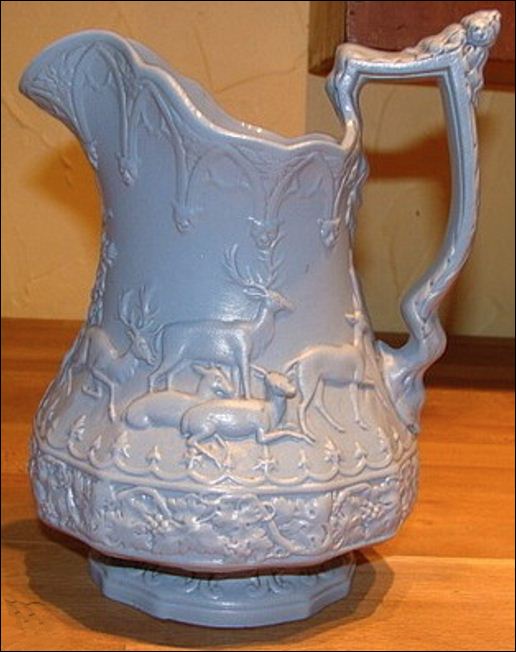
relief moulded parian style
stoneware with a stag pattern
This pattern was produced in cream,
blue and green body
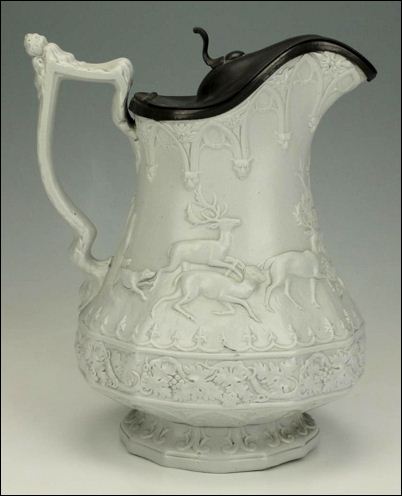 sometimes the jug is fitted with a metal lid |
 S Hughes & Co c.1835-46 |
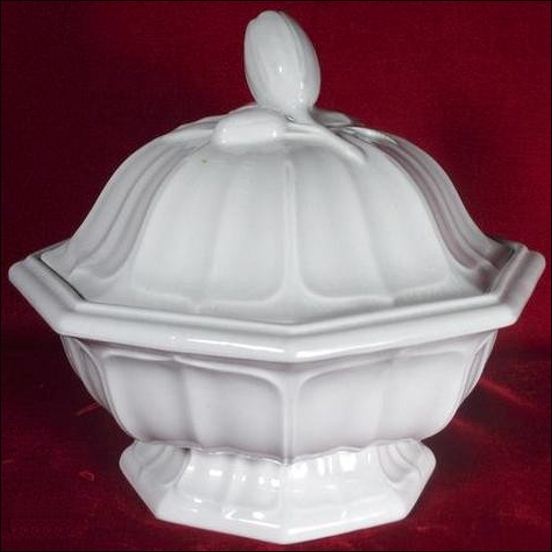
White Ironstone by S. Hughes
& Son in the 'Wrapped Sydenham' or 'Double Sydenham' shape
|
The brothers Stephen & Elijah Hughes had been in partnership together from 1846 to January 1853. Elijah continued on his own account and Stephen continued with his son Thomas as S. Hughes & Son. Stephen died in January 1855 - for a few months ware continued to be marked S. Hughes & Son and a design was registered 17 April 1855 in the name of Stephen Hughes & Son, which is the only recorded instance of that style. Stephen was already dead and his son Thomas soon adopted his sole name as his trading style. |
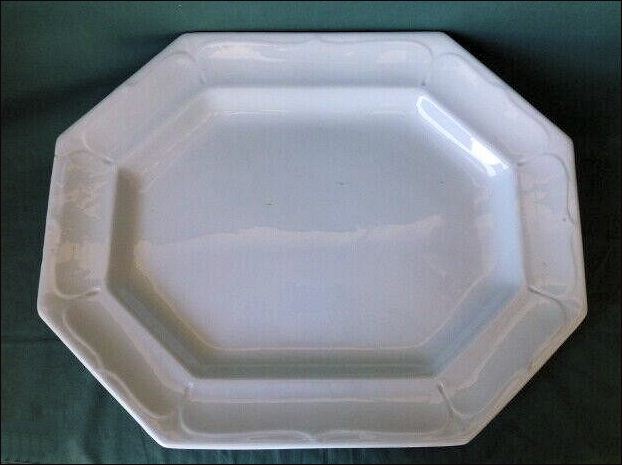 large platter in the 'Wrapped Sydenham' shape |
 Ironstone China S. Hughes & Son c.1853-5 |
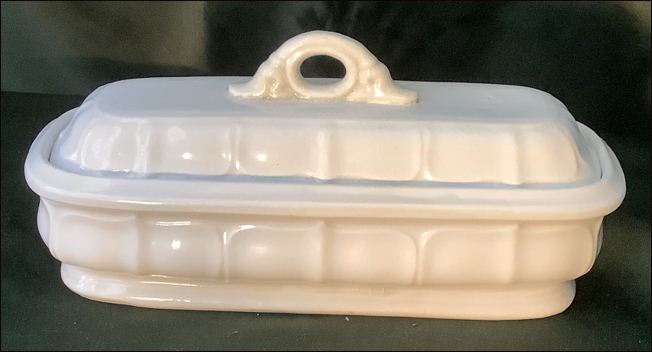 ironstone butter dish |
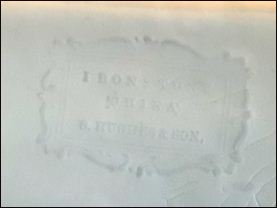 Ironstone China S. Hughes & Son c.1853-5 |
photos of the butter dish courtesy: Mirjana Nichol
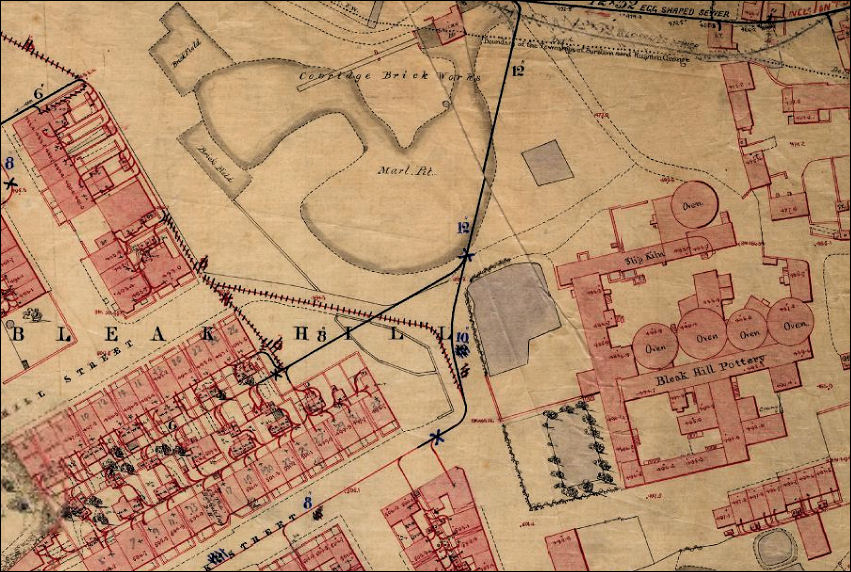
early 1851 map showing
the Bleak Hill Works
the area in front of the works contains
a small garden and a water pond
to the upper left is the Cobridge Brick Works
- click for more on the Bleak Hill Works -
Questions, comments, contributions? email: Steve Birks